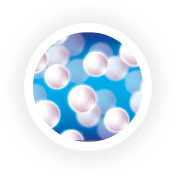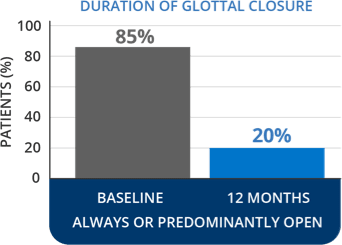IMPORTANT SAFETY INFORMATION FOR PROLARYN® GEL and PLUS
Intended Use/Indications:
PROLARYN GEL is an injectable implant used in the vocal folds to treat vocal fold insufficiency. The gel mixture disappears within 3-6 months and is a temporary implant.
PROLARYN PLUS is an injectable implant used to treat vocal fold insufficiency.
Injection with PROLARYN GEL or PROLARYN PLUS augments or bulks up the displaced or damaged vocal fold so that it can improve speaking. If you have serious difficulties with liquids and/or foods reaching your lungs (aspiration), you may be a candidate for immediate injection.
Contraindications:
You should not be administered PROLARYN GEL or PROLARYN PLUS:
-
If you have any outside objects in your throat or any pain, redness or swelling in the throat due to any throat irritation, injury or infection.
-
If you have been diagnosed with paralysis of the vocal fold on both sides of your throat or if your voice disorders are caused by psychological or emotional causes.
Before your physician injects PROLARYN GEL or PROLARYN PLUS, you should tell your doctor if you have an infection, cancer and any medical conditions that may involve your throat or upper respiratory tract.
Warnings and Precautions:
PROLARYN GEL should be administered by a trained ear, nose and throat doctor who specializes in treatments of the voice box (larynx) such as an otolaryngologist or an experienced head and neck surgeon.
For PROLARYN GEL, lack of effect is possible. In some cases, initial treatment may not work and additional injections are not beneficial.
For PROLARYN PLUS, therapy should be delayed at least 6 months following the onset of vocal fold paralysis and/or until an adequate trial of voice therapy or rehabilitation has been made.
Some injectable implants have been associated with hardening of the tissues at the injection site, movement of particles from the injection site to other parts of body and/or allergic or autoimmune reactions.
PROLARYN GEL and PROLARYN PLUS should not be injected into blood vessels. Injection into blood vessels may cause a blockage leading to serious side effects that can be life threatening. Do not over-inject the vocal fold. In extreme cases site rupture may occur if your vocal folds are over-injected by your physician.
Before you take PROLARYN GEL or PROLARYN PLUS, you should tell your doctor if you have had multiple surgeries as you may not be an appropriate candidate for bulking injection treatment. The product must be injected into healthy tissue to work. The product may not adhere appropriately to scar tissue and injured tissue from previous surgeries.
PROLARYN GEL and PROLARYN PLUS may cause serious side effects that can be life threatening. Call your doctor or get medical help right away if you have trouble swallowing or breathing any time after treatment with PROLARYN GEL or PROLARYN PLUS. Treatment with PROLARYN GEL or PROLARYN PLUS can block your airway immediately after treatment and up to 7 days following injection. This can occur from aggressive vocal fold injection, over-injection of the vocal fold or swelling of the throat due to injury of the voice box (larynx) during the injection procedure.
For PROLARYN GEL and PROLARYN PLUS, the injection procedure and the associated surgical instruments used have a small but inherent risk of infection and/or bleeding.
Also, tell your doctor if you are pregnant or plan to become pregnant. (It is not known if PROLARYN GEL or PROLARYN PLUS can harm your unborn baby.)
Post Market Surveillance:
The following adverse events were received from post-marketing surveillance for PROLARYN GEL: shortness of breath, itchy skin, and cough.
The following adverse events were received from post-marketing surveillance for PROLARYN PLUS: infection, over-injection/under-injection, ineffective treatment, tissue displacement, exposed material, superficial injection, edema, pain, stiffness at injection site and extraction of material.
For full safety information including directions for use, storage, and disposal, please visit www.prolaryn.com or call Merz Therapeutics Customer Solutions at 855-463-7989.
Caution: Rx Only.
Please see Instructions for Use for PROLARYN GEL and PROLARYN PLUS or call Merz Therapeutics Customer Solutions at 855-463-7989
IMPORTANT SAFETY INFORMATION FOR PROLARYN® GEL and PLUS
Intended Use/Indications:
PROLARYN GEL is indicated as a resorbable implant material to aid in surgical reconstructions as a space occupying material in laryngeal surgical procedures for vocal fold medialization and augmentation. PROLARYN GEL is a temporary implant and resorbs within a period of 3-6 months.
PROLARYN PLUS is indicated for vocal fold medialization and vocal fold insufficiency that may be improved by injection of a soft tissue bulking agent. PROLARYN PLUS injection augments the size of the displaced or deformed vocal fold so that it may meet the opposing fold at the midline for improved phonation. Vocal fold insufficiency associated with serious aspiration difficulties may be an urgent indication.
Contraindications:
PROLARYN GEL and PROLARYN PLUS are contraindicated:
-
In the presence of foreign bodies, acute inflammation, infection, inadequately controlled malignancy of rapidly advancing disease when these involve the laryngeal or upper respiratory tract.
-
In bilateral laryngeal paralysis and vocal disorders of psychogenic or emotional origin.
Warnings and Precautions:
PROLARYN GEL should be used only by trained otolaryngologists or experienced head and neck surgeons.
Lack of effect is possible. In some cases, initial treatment with PROLARYN GEL may not be effective and additional injections may be indicated.
PROLARYN PLUS should not be injected into the airway. Confirm placement of needle tip visually before initiating PROLARYN PLUS injection. PROLARYN PLUS should not be injected into organs or other structures that could be damaged by a space occupying implant.
PROLARYN PLUS therapy should be delayed at least six months following the onset of paralysis and/or until an adequate trial of voice rehabilitation has been made.
Some injectable implants have been associated with hardening of the tissues at an injection site, migration of particles from an injection site to other parts of the body and/or allergic or autoimmune reactions.
PROLARYN GEL and PROLARYN PLUS should not be injected into blood vessels. Injection into blood vessels may cause platelet aggregation, vascular occlusion, infarction, embolic phenomena or hemolysis.
Safety and effectiveness of PROLARYN GEL and PROLARYN PLUS during pregnancy have not been established.
PROLARYN GEL and PROLARYN PLUS require viable tissue for effectiveness. Scar tissue and significantly compromised tissue may not coapt appropriately. Patients who have had multiple surgeries may not be appropriate candidates for bulking injection treatment.
Do not over inject the vocal fold. PROLARYN GEL and PROLARYN PLUS can be easily added in subsequent injections but cannot be easily removed. In extreme cases site rupture could occur.
Airway obstruction following vocal fold injection can occur immediately or at any time up to seven (7) days following injection. Airway obstruction results from aggressive vocal fold injection, over-injection, or laryngeal edema from trauma and manipulation of the larynx. Airway obstruction can often be prevented by intraoperative and postoperative steroid treatment and by minimizing laryngeal trauma and manipulation.
The PROLARYN GEL and PROLARYN PLUS injection procedure and the associated instrumentation procedures have small, but inherent risks of infection and/or bleeding like similar otolaryngology procedures. The patient may experience slight discomfort during and following the procedure. The usual precautions associated with otolaryngology procedures, specifically vocal fold injection, should be followed.
Care should be taken with the injection of PROLARYN GEL and PROLARYN PLUS, as with any surgical or implantation procedure, to avoid infection during the injection procedure. If infection occurs and cannot be corrected, if may be necessary to remove the implant.
Do not re-sterilize or store partially used syringes for later use. PROLARYN GEL and PROLARYN PLUS are supplied sterile and non-pyrogenic in a sealed foil pouch and are intended for single patient use only.
The foil pouch should be carefully examined to verify that neither the pouch nor the PROLARYN GEL or PROLARYN PLUS syringe has been damaged during shipment. Do not use if the foil pouch is compromised or the syringe has been damaged. Do not use if the syringe end cap or syringe plunger is not in place.
Use of needles smaller in diameter than 26 gauge may increase the incidence of needle occlusion.
Post Market Surveillance:
PROLARYN GEL has had the following adverse events reported during post market surveillance: dyspnea, pruritus, and cough.
PROLARYN PLUS has had the following adverse events reported during post market surveillance: infection, over injection/under injection, ineffective treatment, tissue displacement, exposed material, superficial injection, edema, pain, stiffness at injection site, extraction of material, voice changes, dyspnea, airway obstruction, nodule, cough, hypersensitivity reactions including anaphylaxis, urticaria, erythema, facial edema, pruritus, and hives.
For full safety information including directions for use, storage, and disposal, please visit www.prolaryn.com or call Merz Therapeutics Customer Solutions at 855-463-7989.
Caution: Rx Only.
Please see Instructions for Use for PROLARYN GEL and PROLARYN PLUS or call Merz Therapeutics Customer Solutions at 855-463-7989







